Similarity and Transformations
When discussing similarity transformations, there are two terms to consider: similarity and transformation. Let's start with a little introduction on what transformation and similarity mean.
A transformation in geometry means to change the position or the shape of a geometric figure.
Similarity is a property of geometric figures where the figures are of the same shape but different sizes.
We say two figures are similar when one can be obtained from the other because the ratio of their corresponding sides is equal. Similar figures are of the same shape but different sizes. Consider the figure below.
 Similar triangles - StudySmarter Originals
Similar triangles - StudySmarter Originals
The figure above shows two triangles of different sizes. The ratio of their corresponding sides is also equal.
So, the triangles are similar. Now we know what transformation and similarity are individually, Let's see what similarity transformation is.
What is a Similarity Transformation?
When you have two figures and one is being enlarged or reduced, we call that a similarity transformation.
A similarity transformation is when a figure is transformed into another through enlargement or reduction in size.
The figure in which the shape is being transformed into is called an image, while the original figure is called a pre-image.
When dealing with similarity transformations, you will need a scaling factor. To review the scale factor, go to Volume, Area, Length and Dilations. From this article, recall if the scale factor is , then the figure is being reduced. If , then the figure is being enlarged.
Every point gets dilated from a fixed point called the center of dilation. Consider the figure below.
 A similarity transformation of a small triangle into a larger one - StudySmarter Originals
A similarity transformation of a small triangle into a larger one - StudySmarter Originals
In the above figure, point is the center of dilation, fixed point used when dealing with scale factors. is being dilated to , meaning it's an enlargement because is smaller than . If you take the distance of to you will get a fraction that is equal to what you'll get from taking the distance from to . This means that the property of similarity is still maintained despite the enlargement or reduction of the size of the figure. Mathematically, we write:
The prime notation (denoted as an apostrophe, ' ) is sometimes used to distinguish the labeling of the image and the pre-image.
Let's look at an example to show what we mean.
Given below with coordinates, a center of dilation , and a scale factor of 2.
Apply the dilation to the polygon and plot .
Solution:
Step 1: We will start by drawing the pre-image .
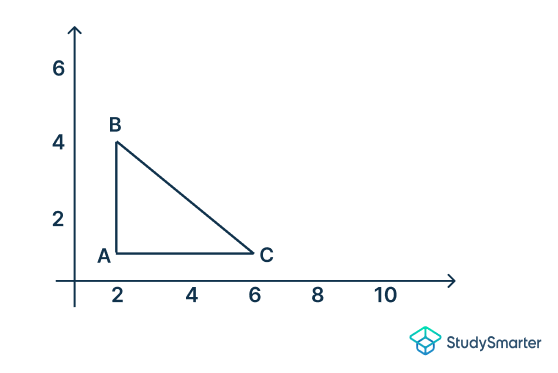
Step 2: From the question, we see that the scaling factor is 2. Notice that the scale factor is greater than 1. This means that it's an enlargement. So, you multiply each x and y co-ordinate of by the scaling factor, 2. See the table below.
| (x, y) | (2x, 2y) |
| A (2, 1) | |
| B ( 2, 3) | |
| C (5, 1) | |
Step 3: We have multiplied by 2 to get the coordinates on the right side of the table above. If you draw these new coordinates on the graph, you'll get:
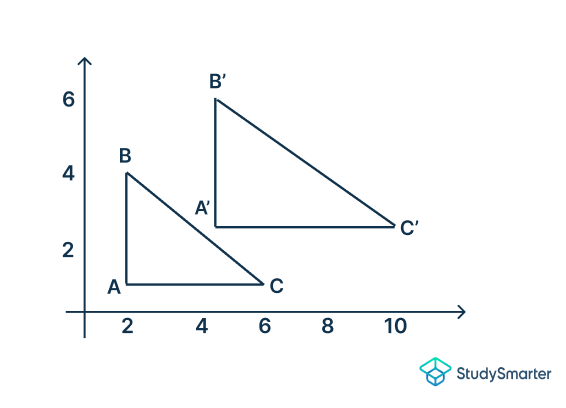
As you can see,
is the pre-image that has been transformed to the image
.
Properties of similarity transformations
Here are some properties of similarity transformations.
They occur when a figure is enlarged or reduced to produce an image of the figure.
The corresponding sides of the pre-image and its image should be of equal proportion.
The coordinates of the figure and its image should be of equal proportion.
There is a scale factor . If there is a figure , the image of the figure will be .
Finding similarity transformations - Examples
If the center of dilation is (0,0), we can multiply each x and y coordinate by the scale factor, k, to obtain the coordinates of the preimage. Mathematically,
| Pre-Image Coordinate | Image Coordinate |
| x,y | |
The center of dilation can be any point on the cartesian plane, however (0,0) is the most common in practice.
Now, let's look at how to determine if two figures are similar or not with the following examples.
The figures on the graph below show shapes with coordinates Determine if they are similar or not.
Step 1: Make a diagram
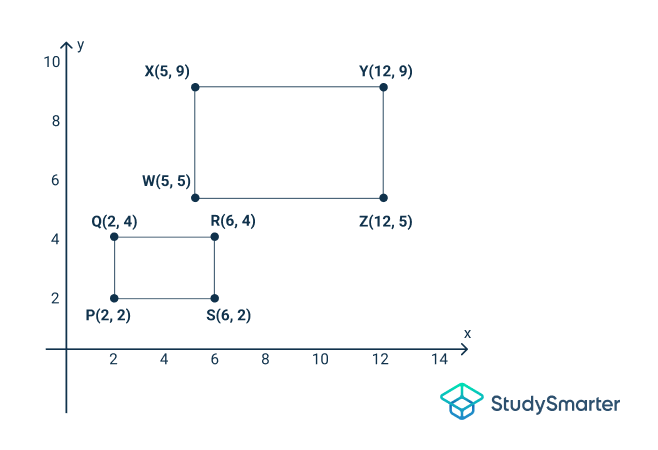
As you can see from the graph, the figures have been dilated meaning that some transformation has taken place.
Step 2: The fastest way to check their similarities is to compare the coordinates of both figures. The first figure is and the second is . First, we need to identify corresponding vertices. The rectangles are both in landscape orientation, so we can match the bottom left on one to the bottom left of the other and so on. You should get that P corresponds to W (both bottom left), S corresponds to Z (bottom right), Q to X (top left), and R to Y (top right).
Next, we check
Step 3: Subbing in coordinates in the above equation, we get
As you can see, the coordinates are not equal so similarity does not exist.
You'll get the ratio of each coordinate to see if they will have the same scale factor.
The first set of coordinates to compare is . The ratio will be . They are equal.
The second set is (The ratio will be . Our result is not equal meaning that the figures cannot be similar. If we had got instead of , then we would have continued with the next coordinate to see if we would get another as the scale factor. The scale factor differs so, the figures are not similar.
Another way to go about this is to look at the graph itself. You should compare the corresponding sides of the figures and see if they are of the same proportion.
From the figure, is 2 and is 4. The proportion here is which is .
is 4 and is 7. The proportion here is . is very different from .
Therefore, similarity does not exist.
Other Types of Similarity Transformations
There are other types of transformation in geometry like reflection, rotation, and translation. As mentioned at the beginning of this article, examples involving these ones can be found in the article on Transformation.
Reflections
Reflection is when a figure is flipped to get a mirror image.
 Reflected Images - StudySmarter Originals
Reflected Images - StudySmarter Originals
Rotations
Rotation is when the figure is turned about at a fixed point.
 Rotated Images - StudySmarter Originals
Rotated Images - StudySmarter Originals
Translations
Translation is simply sliding the figure across the plane.
 Translated Images - StudySmarter Originals
Translated Images - StudySmarter Originals
These types of transformation mainly produce images that are congruent to the original figures but sometimes they can be used when similarity cannot be determined easily. Let's see how with the examples below.
Determine if the following figures are similar or not.
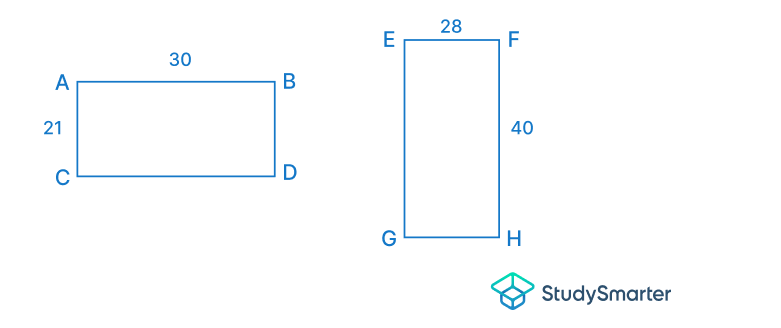
You can't really tell if they are similar by just looking at it because they are placed in different positions. Let's rotate and then translate the first figure and see the outcome.
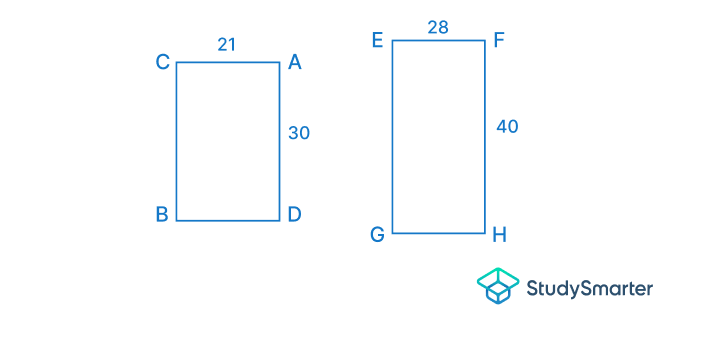
After rotating and translating, the above figure was produced. As you can see, they are both in the same orientation and you can now make comparisons using corresponding parts.
The parts are in the same proportion. Therefore, they are similar.
Similarity Transformations - Key takeaways
- Similarity transformation is when a figure is transformed into another through dilation. Dilation means to enlarge and reduce in size.
- We say two figures are similar when the ratios of their corresponding sides are equal.
- The figure into which the shape is being transformed is called an image, and the original shape is called the pre-image.
- If the center of dilation is 0, you just multiply the x and y coordinates of the pre-image by the scale factor to get the coordinates of the new image.
- The center of dilation is a fixed point where every point gets dilated from.
- Other types of transformation in geometry include reflection, rotation, and translation.


















